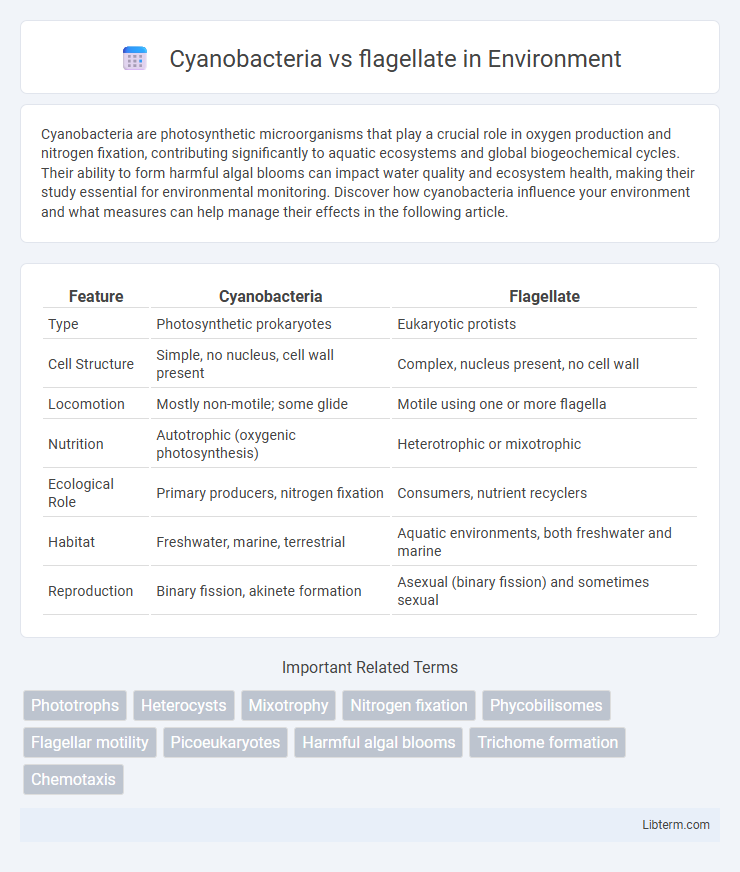Cyanobacteria are photosynthetic microorganisms that play a crucial role in oxygen production and nitrogen fixation, contributing significantly to aquatic ecosystems and global biogeochemical cycles. Their ability to form harmful algal blooms can impact water quality and ecosystem health, making their study essential for environmental monitoring. Discover how cyanobacteria influence your environment and what measures can help manage their effects in the following article.
Table of Comparison
| Feature | Cyanobacteria | Flagellate |
|---|---|---|
| Type | Photosynthetic prokaryotes | Eukaryotic protists |
| Cell Structure | Simple, no nucleus, cell wall present | Complex, nucleus present, no cell wall |
| Locomotion | Mostly non-motile; some glide | Motile using one or more flagella |
| Nutrition | Autotrophic (oxygenic photosynthesis) | Heterotrophic or mixotrophic |
| Ecological Role | Primary producers, nitrogen fixation | Consumers, nutrient recyclers |
| Habitat | Freshwater, marine, terrestrial | Aquatic environments, both freshwater and marine |
| Reproduction | Binary fission, akinete formation | Asexual (binary fission) and sometimes sexual |
Introduction to Cyanobacteria and Flagellates
Cyanobacteria are photosynthetic prokaryotes capable of oxygenic photosynthesis, playing a crucial role in aquatic ecosystems by producing oxygen and fixing nitrogen. Flagellates, a diverse group of eukaryotic protists, use one or more whip-like flagella for locomotion and feeding, often functioning as important consumers or parasites in food webs. Both cyanobacteria and flagellates contribute significantly to nutrient cycling and energy flow in marine and freshwater environments.
Evolutionary Origins and Classification
Cyanobacteria, belonging to the phylum Cyanobacteria, are photosynthetic prokaryotes that played a crucial role in oxygenating Earth's atmosphere over 2.5 billion years ago, marking their evolutionary origin among the earliest life forms. Flagellates, which include diverse eukaryotic protists such as kinetoplastids and euglenoids, evolved later with complex cellular organization featuring membrane-bound organelles and motility driven by one or more flagella. Classification of cyanobacteria is based on their prokaryotic structure and photosynthetic pigments, while flagellates are classified within multiple eukaryotic lineages distinguished by flagellar structure, metabolism, and genetic markers.
Structural Differences Between Cyanobacteria and Flagellates
Cyanobacteria are prokaryotic microorganisms characterized by the absence of membrane-bound organelles and typically possess a rigid cell wall composed of peptidoglycan, while flagellates are eukaryotic protists with complex cellular structures including a nucleus and membrane-bound organelles. Flagellates possess one or more whip-like flagella for locomotion, whereas cyanobacteria may have simpler motility mechanisms such as gliding and often lack true flagella. The chlorophyll a-containing photosynthetic apparatus in cyanobacteria is embedded within thylakoid membranes, contrasting with flagellates that may exhibit diverse pigmentation and organelle arrangements depending on their taxonomic group.
Modes of Nutrition and Energy Acquisition
Cyanobacteria utilize photosynthesis as their primary mode of nutrition, capturing light energy through chlorophyll to convert carbon dioxide and water into organic compounds and oxygen. Flagellates exhibit diverse nutritional modes, including heterotrophy, phagotrophy, and some mixotrophic species capable of both photosynthesis and ingestion of organic matter. Energy acquisition in cyanobacteria is autotrophic, relying on light energy, while flagellates can be heterotrophic or mixotrophic, depending on environmental conditions and species-specific adaptations.
Habitat Diversity and Environmental Roles
Cyanobacteria thrive in diverse habitats including freshwater, marine environments, and terrestrial ecosystems, playing crucial roles in nitrogen fixation and oxygen production through photosynthesis. Flagellates inhabit various aquatic environments, from freshwater to marine systems, and contribute significantly to nutrient cycling and food web dynamics by preying on bacteria and algae. Both groups influence ecosystem productivity and biogeochemical processes, with cyanobacteria primarily driving primary production and flagellates facilitating energy transfer in microbial food chains.
Reproduction and Life Cycles
Cyanobacteria reproduce primarily through binary fission, a simple asexual process enabling rapid population growth in aquatic environments, while flagellates exhibit more diverse reproductive strategies including both asexual binary fission and sexual reproduction via gamete fusion. Cyanobacteria maintain a relatively uniform life cycle dominated by vegetative cells, often forming resistant spores called akinetes under stress conditions. Flagellates have complex life cycles that may involve multiple morphological stages and alternation between haploid and diploid phases, facilitating adaptation to varying environmental conditions.
Ecological Significance in Aquatic Ecosystems
Cyanobacteria contribute significantly to aquatic ecosystems through oxygenic photosynthesis, nitrogen fixation, and forming the base of many aquatic food webs, supporting diverse microbial and metazoan life. Flagellates, including heterotrophic and mixotrophic species, play a crucial role in nutrient cycling by consuming bacteria and organic matter, thus maintaining water quality and influencing carbon transfer within the microbial loop. Both groups are integral to ecosystem productivity and stability, with cyanobacteria often influencing primary production and flagellates regulating microbial population dynamics.
Impact on Water Quality and Algal Blooms
Cyanobacteria often produce harmful algal blooms (HABs) that release toxins, leading to deteriorated water quality and posing risks to aquatic life and human health. Flagellates generally contribute to water ecosystems by grazing on bacteria and other small particles, helping control algal populations without producing toxins. The dominance of cyanobacteria in nutrient-rich waters frequently results in oxygen depletion and disrupted aquatic ecosystems, whereas flagellate activity can mitigate these effects through natural biocontrol mechanisms.
Biotechnological and Industrial Applications
Cyanobacteria are utilized extensively in biotechnological applications for biofuel production, wastewater treatment, and as biofertilizers due to their photosynthetic efficiency and nitrogen-fixing capabilities. Flagellates, such as certain protists, play a crucial role in bioremediation and nutrient recycling within aquaculture systems, enhancing biomass production through their motility and predatory behaviors. Industrially, cyanobacteria's ability to produce high-value compounds like phycobiliproteins and polyhydroxyalkanoates makes them valuable, while flagellates contribute to maintaining ecological balance in bioreactors and sustainable fish farming.
Comparative Summary: Cyanobacteria vs. Flagellates
Cyanobacteria are photosynthetic prokaryotes known for oxygenic photosynthesis and nitrogen fixation, characterized by their blue-green pigment and simple cellular structure without flagella for motility. Flagellates, primarily eukaryotic protists, possess one or more flagella enabling diverse locomotion methods, and they exhibit heterotrophic or mixotrophic nutrition modes. Comparative analysis highlights cyanobacteria's autotrophic efficiency and ecological role in oxygen production, contrasting with flagellates' adaptability and mobility in aquatic ecosystems.
Cyanobacteria Infographic

 libterm.com
libterm.com